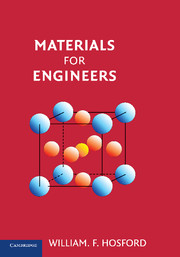Book contents
- Frontmatter
- Contents
- Preface
- 1 Introduction
- 2 Phases
- 3 Diffusion
- 4 Mechanical Behavior
- 5 Mechanical Failure
- 6 Annealing
- 7 Iron and Steel
- 8 Nonferrous Metals
- 9 Casting and Welding
- 10 Solid Shaping
- 11 Polymers
- 12 Polymer Processing
- 13 Glasses
- 14 Crystalline Ceramics
- 15 Powder Processing
- 16 Pottery and Concrete
- 17 Composites
- 18 Carbon
- 19 Fibers, Foams, and Porous Materials
- 20 Electrical Properties
- 21 Optical and Thermal Properties
- 22 Magnetic Materials
- 23 Corrosion
- 24 Modern Manufacturing Techniques, Surface Treatments, and Recycling
- APPENDIX 1 Wood
- APPENDIX 2 Miller Indices for Planes and Directions
- APPENDIX 3 X-ray Diffraction
- APPENDIX 4 Surfaces
- APPENDIX 5 Dislocations
- APPENDIX 6 Avrami Kinetics
- APPENDIX 7 Organic Chemistry
- APPENDIX 8 Average Molecular Weight
- APPENDIX 9 Bond Geometry in Compounds
- APPENDIX 10 Weibull Analysis
- Index
- Conversions
16 - Pottery and Concrete
Published online by Cambridge University Press: 05 June 2012
- Frontmatter
- Contents
- Preface
- 1 Introduction
- 2 Phases
- 3 Diffusion
- 4 Mechanical Behavior
- 5 Mechanical Failure
- 6 Annealing
- 7 Iron and Steel
- 8 Nonferrous Metals
- 9 Casting and Welding
- 10 Solid Shaping
- 11 Polymers
- 12 Polymer Processing
- 13 Glasses
- 14 Crystalline Ceramics
- 15 Powder Processing
- 16 Pottery and Concrete
- 17 Composites
- 18 Carbon
- 19 Fibers, Foams, and Porous Materials
- 20 Electrical Properties
- 21 Optical and Thermal Properties
- 22 Magnetic Materials
- 23 Corrosion
- 24 Modern Manufacturing Techniques, Surface Treatments, and Recycling
- APPENDIX 1 Wood
- APPENDIX 2 Miller Indices for Planes and Directions
- APPENDIX 3 X-ray Diffraction
- APPENDIX 4 Surfaces
- APPENDIX 5 Dislocations
- APPENDIX 6 Avrami Kinetics
- APPENDIX 7 Organic Chemistry
- APPENDIX 8 Average Molecular Weight
- APPENDIX 9 Bond Geometry in Compounds
- APPENDIX 10 Weibull Analysis
- Index
- Conversions
Summary
Pottery was the first man-made material. The oldest known pottery is dated at 27,000 to 23,000 B.C. Pottery is made by shaping clay, drying it, and then firing it at an elevated temperature, which changes its chemical structure.
Clay
There are several forms of clay. All are aluminosilicates. Many contain other elements. Figure 16.1 shows the plate-like structure of kaolinite, Al2(Si2O5)(OH)4. Water absorbed between platelets allows them to slide easily over one another.
Typical clays used for ceramics often contain other materials including ground quartz (SiO2) and a flux such as a feldspar, which is an aluminosilicate containing Na+, K+, and Ca2+.
Processing of Clay Products
Clay is shaped either by pressing it into the desired shape or by slip casting. Slip is a suspension of clay in water made by adding a small amount of a deflocculant (often sodium silicate or soda ash), which allows the clay to be suspended in water. The slip is poured into a plaster of paris mold that absorbs water and causes the clay near the surface of the plaster to become solid. When this solid reaches the desired thickness, the mold is emptied and the resulting shape removed. Figure 16.2 illustrates the process.
The shape is fired only after it is allowed to air dry. Some shrinkage occurs during air drying. After air drying, the shape is said to be green and must be handled with care because it has little strength. Next it is fired usually between 900 and 1400°C.
- Type
- Chapter
- Information
- Materials for Engineers , pp. 160 - 165Publisher: Cambridge University PressPrint publication year: 2008



